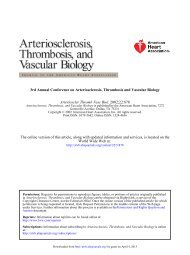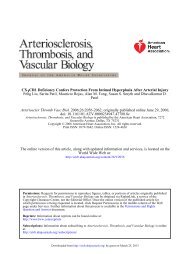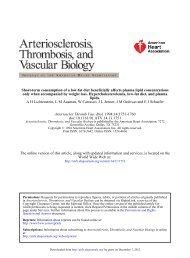Bloch and Richard T. Lee P. Christian Schulze, Heling Liu, Elizabeth ...
Bloch and Richard T. Lee P. Christian Schulze, Heling Liu, Elizabeth ...
Bloch and Richard T. Lee P. Christian Schulze, Heling Liu, Elizabeth ...
You also want an ePaper? Increase the reach of your titles
YUMPU automatically turns print PDFs into web optimized ePapers that Google loves.
2670 Arterioscler Thromb Vasc Biol. December 2006<br />
Figure 4. GSNO stimulation does not affect Txnip/thioredoxin<br />
binding; 293 cells were transfected with plasmids for overexpression<br />
of wildtype Txnip <strong>and</strong> Xpress-tagged thioredoxin (wildtype<br />
or C69S mutated thioredoxin). Immunoprecipitation using<br />
anti-Txnip antibodies followed by Western analysis for the<br />
Xpress-tag revealed no differences of Txnip/thioredoxin binding<br />
in response to GSNO stimulation.<br />
known about the specific transcriptional regulation of Txnip<br />
expression by NO. To investigate the mechanisms underlying<br />
NO’s suppressive effects on Txnip expression, RPaSMCs<br />
were transfected with a series of constructs of the human<br />
Txnip promoter driving expression of firefly luciferase (Figure<br />
3A). Basal expression of those constructs reveals that the<br />
Txnip promoter was active in RPaSMC’s (Figure 3B). Incubation<br />
of RPaSMCs transfected with the Txnip promoter<br />
constructs in the presence of GSNO strongly suppressed<br />
luciferase activity only in cells transfected with the fulllength<br />
(1777) Txnip promoter (4212% of unstimulated<br />
cells; P0.001) (Figure 3C). This finding suggests the<br />
presence of an NO-responsive cis-regulatory element in the<br />
Txnip promoter between 1777 <strong>and</strong> 1127 bp upstream of<br />
the ATG codon.<br />
High Glucose Prevents NO Effects on Txnip<br />
Promoter Activity<br />
Increased glucose levels induce Txnip gene expression both<br />
in vitro <strong>and</strong> in vivo. 21,24,25 We, therefore, tested whether high<br />
glucose (22.4 mmol/L) induces Txnip promoter activity in<br />
RPaSMC’s. Transfection of RPaSMC with full-length Txnip<br />
promoter constructs followed by incubation in high glucose<br />
(22.4 mmol/L) or low glucose (5.6 mmol/L) revealed a strong<br />
induction of Txnip promoter activity in RPaSMC’s under<br />
hyperglycemic conditions (3.80.3 fold of unstimulated<br />
cells; P0.001) (Figure 3D). Incubation of transfected cells<br />
with GSNO reduced Txnip promoter activity at 5.6 mmol/L<br />
glucose (-456% versus unstimulated cells; P0.05) but had<br />
no effect at 22.4 mmol/L demonstrating that NO’s effects are<br />
restricted to normoglycemic conditions.<br />
Glucose stimulates Txnip expression in pancreatic -cells<br />
through a carbohydrate response element (ChRE) (400 bp<br />
upstream of the ATG codon). 24 To test whether this regulation<br />
also occurs in RPaSMCs, we transfected cells with<br />
promoter constructs containing the ChRE site (400) <strong>and</strong><br />
constructs with a mutated ChRE site (400 ChRE ). Hypergly-<br />
cemia induced a 2-fold induction of Txnip promoter activity<br />
in cells transfected with wild-type constructs. Mutation of the<br />
ChRE site completely abolished glucose’s induction of Txnip<br />
promoter activity (supplemental Figure I, available online at<br />
http://atvb.ahajournals.org).<br />
GSNO Stimulation Does Not Affect the<br />
Thioredoxin/Txnip Interaction<br />
It has been shown previously that S-nitrosylation of thioredoxin<br />
at Cys69 by NO enhances thioredoxin activity. 14<br />
Because Txnip may bind to thioredoxin at its reactive<br />
cysteine residues of thioredoxin, 7–9 we tested whether NO<br />
modulates Txnip/thioredoxin binding. For these experiments,<br />
we used 293 cells because they have a higher transfection<br />
efficiency than do RPaSMC. Whereas 293 cells have very<br />
low levels of Txnip at baseline, transfection of cells with an<br />
expression plasmid resulted in robust protein expression of<br />
Txnip. To assess the role of thioredoxin independent from its<br />
S-nitrosylation at Cys69 by NO, wild-type thioredoxin <strong>and</strong><br />
C69S-mutated thioredoxin, which is resistant to<br />
S-nitrosylation, 14,15 were overexpressed in 293 cells. Cells<br />
were stimulated with 100 mol/L GSNO for 2 hours. Immunoprecipitation<br />
of Txnip followed by Western analysis for<br />
Xpress–thioredoxin by anti-Xpress antibodies revealed no<br />
differences of Txnip/thioredoxin binding in the presence or<br />
absence of NO (Figure 4). These data show that the binding<br />
of Txnip to thioredoxin is NO-independent <strong>and</strong> that the<br />
regulation of Txnip levels by NO represents an additional<br />
regulatory mechanism by which NO modulates thioredoxin<br />
function.<br />
Discussion<br />
In the current study, we provide evidence that exogenous<br />
administration of NO results in enhanced activity of thioredoxin<br />
through transcriptional regulation of Txnip, the endogenous<br />
inhibitor of thioredoxin, <strong>and</strong> thioredoxin reductase. NO<br />
suppresses expression of Txnip <strong>and</strong> induces expression of<br />
thioredoxin reductase through redox-dependent mechanisms<br />
independent of soluble guanylate cyclase. Promoter analysis<br />
revealed that cis-regulatory elements 1127 bp upstream of<br />
the ATG codon mediate NO’s effects on Txnip transcription.<br />
Hyperglycemia induced Txnip promoter activity through a<br />
carbohydrate-response element, which is not affected by NO<br />
stimulation. The interaction of thioredoxin with Txnip was<br />
not affected by stimulation with NO excluding S-nitrosylation<br />
of thioredoxin as a factor regulating the Txnip/thioredoxin<br />
interaction. These findings reveal a novel mechanism by<br />
which NO regulates thioredoxin activity.<br />
The thioredoxin system is a major thiol reducing system<br />
of the cell <strong>and</strong> has antioxidative <strong>and</strong> anti-apoptotic functions<br />
mediated by reactive cysteines (Cys32 <strong>and</strong> Cys35). 1<br />
Thioredoxin forms a disulfide bond on oxidation <strong>and</strong> in<br />
turn is reduced by thioredoxin reductase <strong>and</strong> NADPH.<br />
Thioredoxin also binds to transcription factors as well as<br />
ASK-1 targeting the latter for ubiquitination <strong>and</strong> degradation.<br />
4,5,26 Recently, Txnip has been described as an endogenous<br />
inhibitor of thioredoxin. 7–9 The interaction of thioredoxin<br />
with Txnip can lead to increased levels of<br />
reactive oxygen species. 8,21 This mechanism may play a<br />
Downloaded from<br />
http://atvb.ahajournals.org/ by guest on July 30, 2013














